六丶人生苦短,我用python【第六篇】
Python基础之函数
三元运算(三目运算),是对简单的条件语句的缩写。
# 书写格式 result = 值1 if 条件 else 值2 # 如果条件成立,那么将 “值1” 赋值给result变量,否则,将“值2”赋值给result变量
基本数据类型补充
set
set集合,是一个无序且不重复的元素集合
class set(object):
"""
set() -> new empty set object
set(iterable) -> new set object Build an unordered collection of unique elements.
"""
def add(self, *args, **kwargs): # real signature unknown
"""
Add an element to a set,添加元素 This has no effect if the element is already present.
"""
pass def clear(self, *args, **kwargs): # real signature unknown
""" Remove all elements from this set. 清除内容"""
pass def copy(self, *args, **kwargs): # real signature unknown
""" Return a shallow copy of a set. 浅拷贝 """
pass def difference(self, *args, **kwargs): # real signature unknown
"""
Return the difference of two or more sets as a new set. A中存在,B中不存在 (i.e. all elements that are in this set but not the others.)
"""
pass def difference_update(self, *args, **kwargs): # real signature unknown
""" Remove all elements of another set from this set. 从当前集合中删除和B中相同的元素"""
pass def discard(self, *args, **kwargs): # real signature unknown
"""
Remove an element from a set if it is a member. If the element is not a member, do nothing. 移除指定元素,不存在不保错
"""
pass def intersection(self, *args, **kwargs): # real signature unknown
"""
Return the intersection of two sets as a new set. 交集 (i.e. all elements that are in both sets.)
"""
pass def intersection_update(self, *args, **kwargs): # real signature unknown
""" Update a set with the intersection of itself and another. 取交集并更更新到A中 """
pass def isdisjoint(self, *args, **kwargs): # real signature unknown
""" Return True if two sets have a null intersection. 如果没有交集,返回True,否则返回False"""
pass def issubset(self, *args, **kwargs): # real signature unknown
""" Report whether another set contains this set. 是否是子序列"""
pass def issuperset(self, *args, **kwargs): # real signature unknown
""" Report whether this set contains another set. 是否是父序列"""
pass def pop(self, *args, **kwargs): # real signature unknown
"""
Remove and return an arbitrary set element.
Raises KeyError if the set is empty. 移除元素
"""
pass def remove(self, *args, **kwargs): # real signature unknown
"""
Remove an element from a set; it must be a member. If the element is not a member, raise a KeyError. 移除指定元素,不存在保错
"""
pass def symmetric_difference(self, *args, **kwargs): # real signature unknown
"""
Return the symmetric difference of two sets as a new set. 对称差集 (i.e. all elements that are in exactly one of the sets.)
"""
pass def symmetric_difference_update(self, *args, **kwargs): # real signature unknown
""" Update a set with the symmetric difference of itself and another. 对称差集,并更新到a中 """
pass def union(self, *args, **kwargs): # real signature unknown
"""
Return the union of sets as a new set. 并集 (i.e. all elements that are in either set.)
"""
pass def update(self, *args, **kwargs): # real signature unknown
""" Update a set with the union of itself and others. 更新 """
pass
一、数字和字符串
对于 数字 和 字符串 而言,赋值、浅拷贝和深拷贝无意义,因为其永远指向同一个内存地址。
import copy
# ######### 数字、字符串 #########
n1 = 123
# n1 = "i am alex age 10"
print(id(n1))
# ## 赋值 ##
n2 = n1
print(id(n2))
# ## 浅拷贝 ##
n2 = copy.copy(n1)
print(id(n2)) # ## 深拷贝 ##
n3 = copy.deepcopy(n1)
print(id(n3))
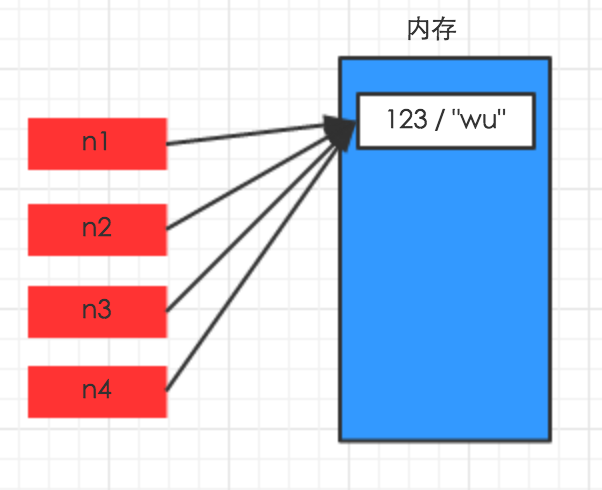
二、其他基本数据类型
对于字典、元祖、列表 而言,进行赋值、浅拷贝和深拷贝时,其内存地址的变化是不同的。
1、赋值
赋值,只是创建一个变量,该变量指向原来内存地址,如:
n1 = {"k1": "wu", "k2": 123, "k3": ["alex", 456]}
n2 = n1
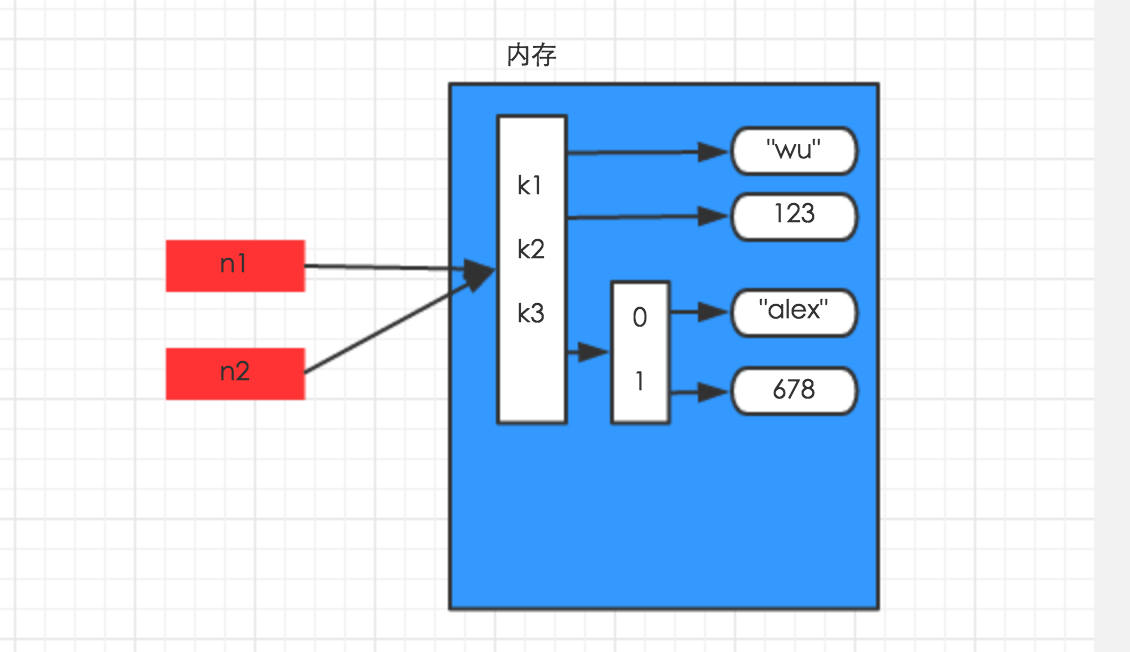
2、浅拷贝
浅拷贝,在内存中只额外创建第一层数据
import copy
n1 = {"k1": "wu", "k2": 123, "k3": ["alex", 456]}
n3 = copy.copy(n1)
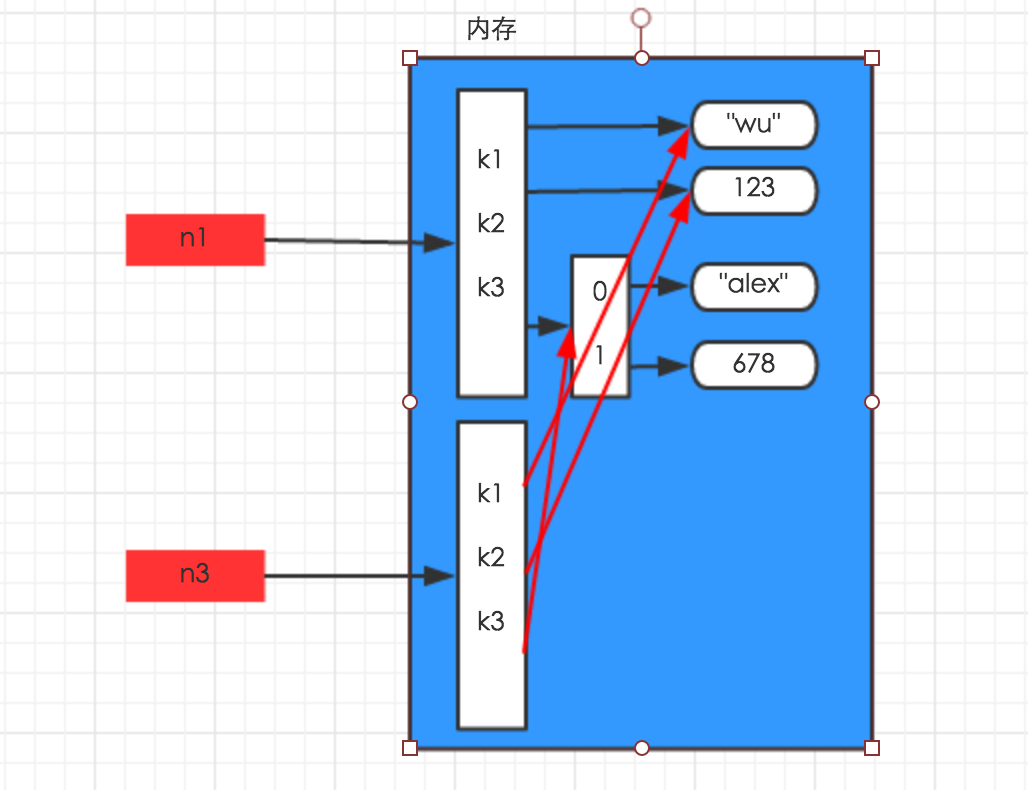
3、深拷贝
深拷贝,在内存中将所有的数据重新创建一份(排除最后一层,即:python内部对字符串和数字的优化)
import copy
n1 = {"k1": "wu", "k2": 123, "k3": ["alex", 456]}
n4 = copy.deepcopy(n1)
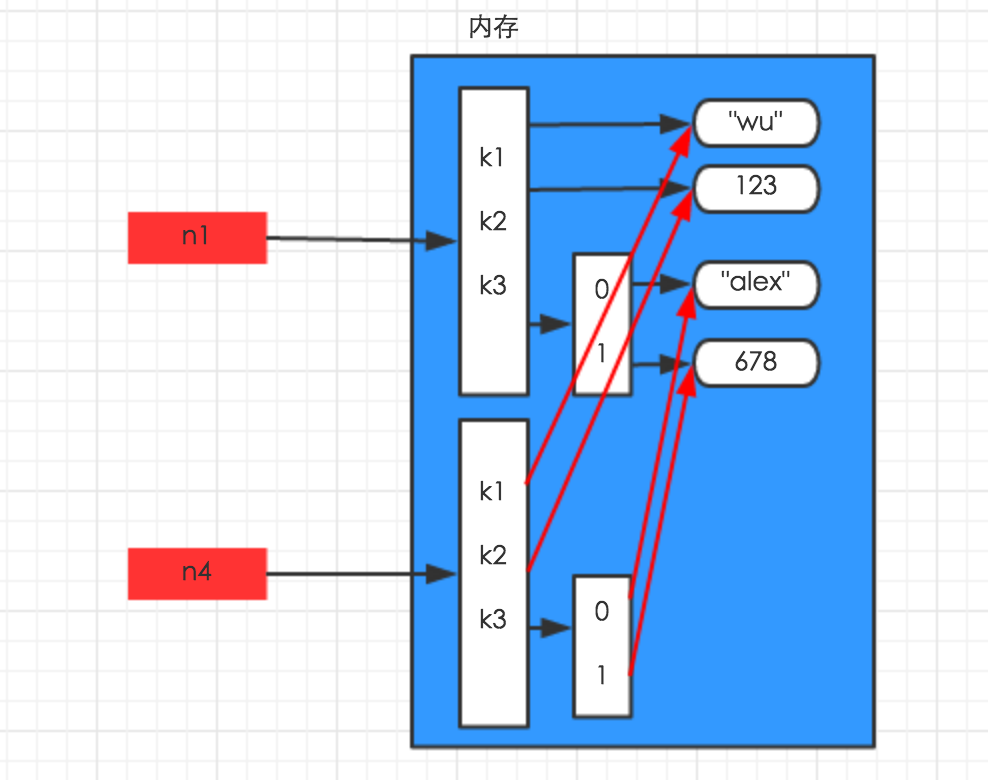
函数
一、背景
在学习函数之前,一直遵循:面向过程编程,即:根据业务逻辑从上到下实现功能,其往往用一长段代码来实现指定功能,开发过程中最常见的操作就是粘贴复制,也就是将之前实现的代码块复制到现需功能处,如下:
while True:
if cpu利用率 > 90%:
#发送邮件提醒
连接邮箱服务器
发送邮件
关闭连接 if 硬盘使用空间 > 90%:
#发送邮件提醒
连接邮箱服务器
发送邮件
关闭连接 if 内存占用 > 80%:
#发送邮件提醒
连接邮箱服务器
发送邮件
关闭连接
腚眼一看上述代码,if条件语句下的内容可以被提取出来公用,如下:
def 发送邮件(内容)
#发送邮件提醒
连接邮箱服务器
发送邮件
关闭连接 while True: if cpu利用率 > 90%:
发送邮件('CPU报警') if 硬盘使用空间 > 90%:
发送邮件('硬盘报警') if 内存占用 > 80%:
对于上述的两种实现方式,第二次必然比第一次的重用性和可读性要好,其实这就是函数式编程和面向过程编程的区别:
- 函数式:将某功能代码封装到函数中,日后便无需重复编写,仅调用函数即可
- 面向对象:对函数进行分类和封装,让开发“更快更好更强...”
函数式编程最重要的是增强代码的重用性和可读性
二、定义和使用
def 函数名(参数):
...
函数体
...
返回值
函数的定义主要有如下要点:
- def:表示函数的关键字
- 函数名:函数的名称,日后根据函数名调用函数
- 函数体:函数中进行一系列的逻辑计算,如:发送邮件、计算出 [11,22,38,888,2]中的最大数等...
- 参数:为函数体提供数据
- 返回值:当函数执行完毕后,可以给调用者返回数据。
1、返回值
函数是一个功能块,该功能到底执行成功与否,需要通过返回值来告知调用者。
以上要点中,比较重要有参数和返回值:
def 发送短信():
发送短信的代码...
if 发送成功:
return True
else:
return False
while True:
# 每次执行发送短信函数,都会将返回值自动赋值给result
# 之后,可以根据result来写日志,或重发等操作
result = 发送短信()
if result == False:
记录日志,短信发送失败...
2、参数
为什么要有参数?
def CPU报警邮件()
#发送邮件提醒
连接邮箱服务器
发送邮件
关闭连接 def 硬盘报警邮件()
#发送邮件提醒
连接邮箱服务器
发送邮件
关闭连接 def 内存报警邮件()
#发送邮件提醒
连接邮箱服务器
发送邮件
关闭连接 while True: if cpu利用率 > 90%:
CPU报警邮件() if 硬盘使用空间 > 90%:
硬盘报警邮件() if 内存占用 > 80%:
内存报警邮件()
无参数实现
def 发送邮件(邮件内容)
#发送邮件提醒
连接邮箱服务器
发送邮件
关闭连接
while True:
if cpu利用率 > 90%:
发送邮件("CPU报警了。")
if 硬盘使用空间 > 90%:
发送邮件("硬盘报警了。")
if 内存占用 > 80%:
发送邮件("内存报警了。")
有参数实现
函数的有三中不同的参数:
- 普通参数
- 默认参数
- 动态参数
# ######### 定义函数 ######### # name 叫做函数func的形式参数,简称:形参
def func(name):
print name # ######### 执行函数 #########
# 'wupeiqi' 叫做函数func的实际参数,简称:实参
func('wupeiqi')
普通参数
def func(name, age = 18):
print "%s:%s" %(name,age)
# 指定参数
func('wupeiqi', 19)
# 使用默认参数
func('alex')
注:默认参数需要放在参数列表最后
默认参数
def func(*args):
print args
# 执行方式一
func(11,33,4,4454,5)
# 执行方式二
li = [11,2,2,3,3,4,54]
func(*li)
动态参数
def func(**kwargs):
print args
# 执行方式一
func(name='wupeiqi',age=18)
# 执行方式二
li = {'name':'wupeiqi', age:18, 'gender':'male'}
func(**li)
动态参数
def func(*args, **kwargs):
print args
print kwargs
动态参数
扩展:发送邮件实例
import smtplib
from email.mime.text import MIMEText
from email.utils import formataddr msg = MIMEText('邮件内容', 'plain', 'utf-8')
msg['From'] = formataddr(["武沛齐",'wptawy@126.com'])
msg['To'] = formataddr(["走人",'424662508@qq.com'])
msg['Subject'] = "主题" server = smtplib.SMTP("smtp.126.com", 25)
server.login("wptawy@126.com", "邮箱密码")
server.sendmail('wptawy@126.com', ['424662508@qq.com',], msg.as_string())
server.quit()
发送邮件实例
内置函数
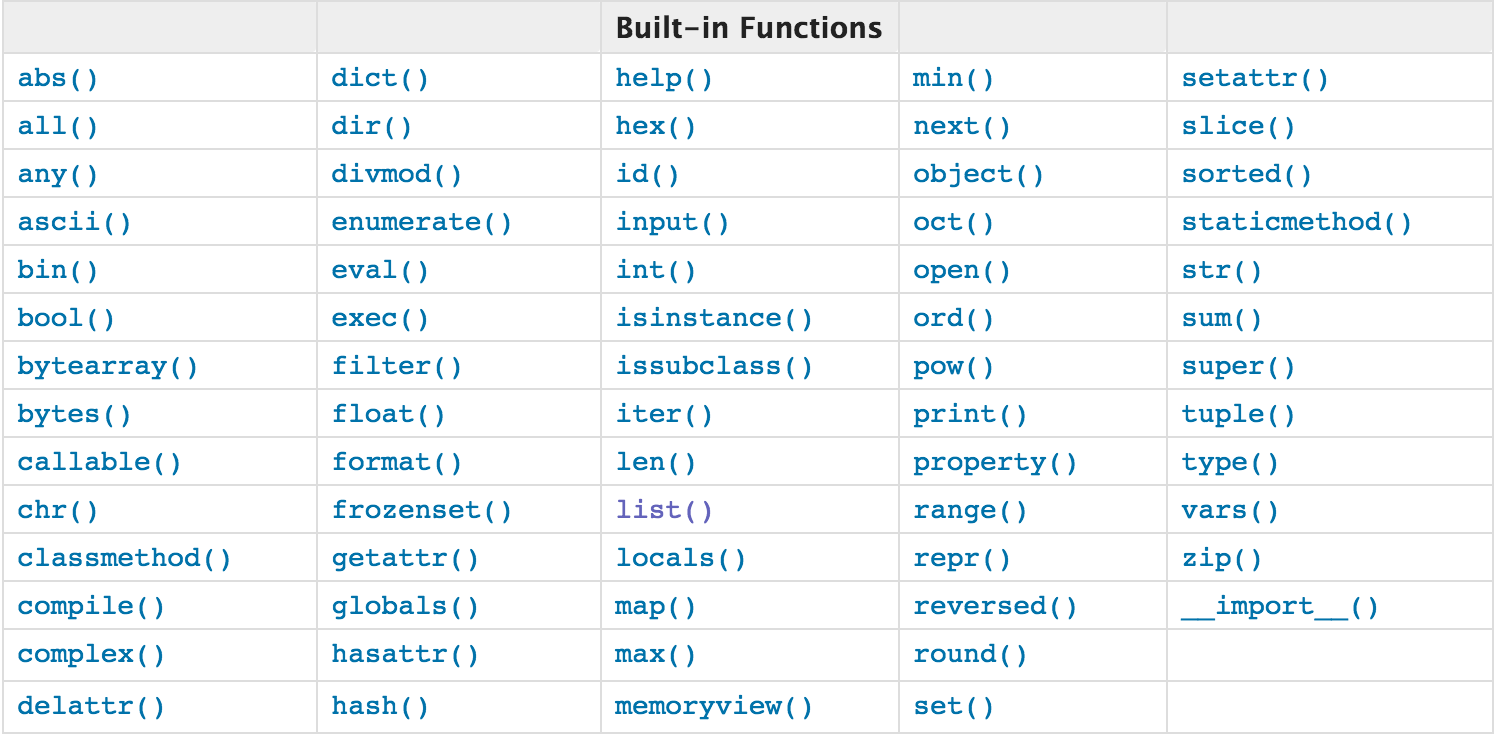
注:查看详细猛击这里
open函数,该函数用于文件处理
操作文件时,一般需要经历如下步骤:
- 打开文件
- 操作文件
一、打开文件
文件句柄 = open('文件路径', '模式')
打开文件时,需要指定文件路径和以何等方式打开文件,打开后,即可获取该文件句柄,日后通过此文件句柄对该文件操作。
打开文件的模式有:
- r ,只读模式【默认】
- w,只写模式【不可读;不存在则创建;存在则清空内容;】
- x, 只写模式【不可读;不存在则创建,存在则报错】
- a, 追加模式【可读; 不存在则创建;存在则只追加内容;】
"+" 表示可以同时读写某个文件
- r+, 读写【可读,可写】
- w+,写读【可读,可写】
- x+ ,写读【可读,可写】
- a+, 写读【可读,可写】
"b"表示以字节的方式操作
- rb 或 r+b
- wb 或 w+b
- xb 或 w+b
- ab 或 a+b
注:以b方式打开时,读取到的内容是字节类型,写入时也需要提供字节类型
二、操作
class file(object)
def close(self): # real signature unknown; restored from __doc__
关闭文件
"""
close() -> None or (perhaps) an integer. Close the file. Sets data attribute .closed to True. A closed file cannot be used for
further I/O operations. close() may be called more than once without
error. Some kinds of file objects (for example, opened by popen())
may return an exit status upon closing.
""" def fileno(self): # real signature unknown; restored from __doc__
文件描述符
"""
fileno() -> integer "file descriptor". This is needed for lower-level file interfaces, such os.read().
"""
return 0 def flush(self): # real signature unknown; restored from __doc__
刷新文件内部缓冲区
""" flush() -> None. Flush the internal I/O buffer. """
pass def isatty(self): # real signature unknown; restored from __doc__
判断文件是否是同意tty设备
""" isatty() -> true or false. True if the file is connected to a tty device. """
return False def next(self): # real signature unknown; restored from __doc__
获取下一行数据,不存在,则报错
""" x.next() -> the next value, or raise StopIteration """
pass def read(self, size=None): # real signature unknown; restored from __doc__
读取指定字节数据
"""
read([size]) -> read at most size bytes, returned as a string. If the size argument is negative or omitted, read until EOF is reached.
Notice that when in non-blocking mode, less data than what was requested
may be returned, even if no size parameter was given.
"""
pass def readinto(self): # real signature unknown; restored from __doc__
读取到缓冲区,不要用,将被遗弃
""" readinto() -> Undocumented. Don't use this; it may go away. """
pass def readline(self, size=None): # real signature unknown; restored from __doc__
仅读取一行数据
"""
readline([size]) -> next line from the file, as a string. Retain newline. A non-negative size argument limits the maximum
number of bytes to return (an incomplete line may be returned then).
Return an empty string at EOF.
"""
pass def readlines(self, size=None): # real signature unknown; restored from __doc__
读取所有数据,并根据换行保存值列表
"""
readlines([size]) -> list of strings, each a line from the file. Call readline() repeatedly and return a list of the lines so read.
The optional size argument, if given, is an approximate bound on the
total number of bytes in the lines returned.
"""
return [] def seek(self, offset, whence=None): # real signature unknown; restored from __doc__
指定文件中指针位置
"""
seek(offset[, whence]) -> None. Move to new file position. Argument offset is a byte count. Optional argument whence defaults to
(offset from start of file, offset should be >= 0); other values are 1
(move relative to current position, positive or negative), and 2 (move
relative to end of file, usually negative, although many platforms allow
seeking beyond the end of a file). If the file is opened in text mode,
only offsets returned by tell() are legal. Use of other offsets causes
undefined behavior.
Note that not all file objects are seekable.
"""
pass def tell(self): # real signature unknown; restored from __doc__
获取当前指针位置
""" tell() -> current file position, an integer (may be a long integer). """
pass def truncate(self, size=None): # real signature unknown; restored from __doc__
截断数据,仅保留指定之前数据
"""
truncate([size]) -> None. Truncate the file to at most size bytes. Size defaults to the current file position, as returned by tell().
"""
pass def write(self, p_str): # real signature unknown; restored from __doc__
写内容
"""
write(str) -> None. Write string str to file. Note that due to buffering, flush() or close() may be needed before
the file on disk reflects the data written.
"""
pass def writelines(self, sequence_of_strings): # real signature unknown; restored from __doc__
将一个字符串列表写入文件
"""
writelines(sequence_of_strings) -> None. Write the strings to the file. Note that newlines are not added. The sequence can be any iterable object
producing strings. This is equivalent to calling write() for each string.
"""
pass def xreadlines(self): # real signature unknown; restored from __doc__
可用于逐行读取文件,非全部
"""
xreadlines() -> returns self. For backward compatibility. File objects now include the performance
optimizations previously implemented in the xreadlines module.
"""
pass
2.x
class TextIOWrapper(_TextIOBase):
"""
Character and line based layer over a BufferedIOBase object, buffer. encoding gives the name of the encoding that the stream will be
decoded or encoded with. It defaults to locale.getpreferredencoding(False). errors determines the strictness of encoding and decoding (see
help(codecs.Codec) or the documentation for codecs.register) and
defaults to "strict". newline controls how line endings are handled. It can be None, '',
'\n', '\r', and '\r\n'. It works as follows: * On input, if newline is None, universal newlines mode is
enabled. Lines in the input can end in '\n', '\r', or '\r\n', and
these are translated into '\n' before being returned to the
caller. If it is '', universal newline mode is enabled, but line
endings are returned to the caller untranslated. If it has any of
the other legal values, input lines are only terminated by the given
string, and the line ending is returned to the caller untranslated. * On output, if newline is None, any '\n' characters written are
translated to the system default line separator, os.linesep. If
newline is '' or '\n', no translation takes place. If newline is any
of the other legal values, any '\n' characters written are translated
to the given string. If line_buffering is True, a call to flush is implied when a call to
write contains a newline character.
"""
def close(self, *args, **kwargs): # real signature unknown
关闭文件
pass def fileno(self, *args, **kwargs): # real signature unknown
文件描述符
pass def flush(self, *args, **kwargs): # real signature unknown
刷新文件内部缓冲区
pass def isatty(self, *args, **kwargs): # real signature unknown
判断文件是否是同意tty设备
pass def read(self, *args, **kwargs): # real signature unknown
读取指定字节数据
pass def readable(self, *args, **kwargs): # real signature unknown
是否可读
pass def readline(self, *args, **kwargs): # real signature unknown
仅读取一行数据
pass def seek(self, *args, **kwargs): # real signature unknown
指定文件中指针位置
pass def seekable(self, *args, **kwargs): # real signature unknown
指针是否可操作
pass def tell(self, *args, **kwargs): # real signature unknown
获取指针位置
pass def truncate(self, *args, **kwargs): # real signature unknown
截断数据,仅保留指定之前数据
pass def writable(self, *args, **kwargs): # real signature unknown
是否可写
pass def write(self, *args, **kwargs): # real signature unknown
写内容
pass def __getstate__(self, *args, **kwargs): # real signature unknown
pass def __init__(self, *args, **kwargs): # real signature unknown
pass @staticmethod # known case of __new__
def __new__(*args, **kwargs): # real signature unknown
""" Create and return a new object. See help(type) for accurate signature. """
pass def __next__(self, *args, **kwargs): # real signature unknown
""" Implement next(self). """
pass def __repr__(self, *args, **kwargs): # real signature unknown
""" Return repr(self). """
pass buffer = property(lambda self: object(), lambda self, v: None, lambda self: None) # default closed = property(lambda self: object(), lambda self, v: None, lambda self: None) # default encoding = property(lambda self: object(), lambda self, v: None, lambda self: None) # default errors = property(lambda self: object(), lambda self, v: None, lambda self: None) # default line_buffering = property(lambda self: object(), lambda self, v: None, lambda self: None) # default name = property(lambda self: object(), lambda self, v: None, lambda self: None) # default newlines = property(lambda self: object(), lambda self, v: None, lambda self: None) # default _CHUNK_SIZE = property(lambda self: object(), lambda self, v: None, lambda self: None) # default _finalizing = property(lambda self: object(), lambda self, v: None, lambda self: None) # default
3.x
三、管理上下文
为了避免打开文件后忘记关闭,可以通过管理上下文,即:
with open('log','r') as f:
...
如此方式,当with代码块执行完毕时,内部会自动关闭并释放文件资源。
在Python 2.7 及以后,with又支持同时对多个文件的上下文进行管理,即:
with open('log1') as obj1, open('log2') as obj2:
pass
lambda表达式
学习条件运算时,对于简单的 if else 语句,可以使用三元运算来表示,即:
# 普通条件语句
if 1 == 1:
name = 'wupeiqi'
else:
name = 'alex' # 三元运算
name = 'wupeiqi' if 1 == 1 else 'alex'
对于简单的函数,也存在一种简便的表示方式,即:lambda表达式
# ###################### 普通函数 ######################
# 定义函数(普通方式)
def func(arg):
return arg + 1 # 执行函数
result = func(123) # ###################### lambda ###################### # 定义函数(lambda表达式)
my_lambda = lambda arg : arg + 1 # 执行函数
result = my_lambda(123)
递归
利用函数编写如下数列:
斐波那契数列指的是这样一个数列 0, 1, 1, 2, 3, 5, 8, 13, 21, 34, 55, 89, 144, 233,377,610,987,1597,2584,4181,6765,10946,17711,28657,46368...
def func(arg1,arg2):
if arg1 == 0:
print arg1, arg2
arg3 = arg1 + arg2
print arg3
func(arg2, arg3) func(0,1)
转自:http://www.cnblogs.com/wupeiqi/articles/5453708.html
六丶人生苦短,我用python【第六篇】的更多相关文章
- Python进阶(六)----装饰器
Python进阶(六)----装饰器 一丶开放封闭原则 开放原则: 增加一些额外的新功能 封闭原则: 不改变源码.以及调用方式 二丶初识装饰器 装饰器: 也可称装饰器函数,诠释开放封闭原则 ...
- 简学Python第六章__class面向对象编程与异常处理
Python第六章__class面向对象编程与异常处理 欢迎加入Linux_Python学习群 群号:478616847 目录: 面向对象的程序设计 类和对象 封装 继承与派生 多态与多态性 特性p ...
- 初学Python(六)——输入输出
初学Python(六)——输入输出 初学Python,主要整理一些学习到的知识点,这次是输入输出. 输入: # -*- coding:utf-8 -*- ''''' python中的输出为print ...
- 第三百六十九节,Python分布式爬虫打造搜索引擎Scrapy精讲—elasticsearch(搜索引擎)用Django实现搜索功能
第三百六十九节,Python分布式爬虫打造搜索引擎Scrapy精讲—elasticsearch(搜索引擎)用Django实现搜索功能 Django实现搜索功能 1.在Django配置搜索结果页的路由映 ...
- 第三百六十五节,Python分布式爬虫打造搜索引擎Scrapy精讲—elasticsearch(搜索引擎)的基本查询
第三百六十五节,Python分布式爬虫打造搜索引擎Scrapy精讲—elasticsearch(搜索引擎)的基本查询 1.elasticsearch(搜索引擎)的查询 elasticsearch是功能 ...
- 第三百六十四节,Python分布式爬虫打造搜索引擎Scrapy精讲—elasticsearch(搜索引擎)的mapping映射管理
第三百六十四节,Python分布式爬虫打造搜索引擎Scrapy精讲—elasticsearch(搜索引擎)的mapping映射管理 1.映射(mapping)介绍 映射:创建索引的时候,可以预先定义字 ...
- 孤荷凌寒自学python第六十九天学习并实践beautifulsoup对象用法2
孤荷凌寒自学python第六十九天学习并实践beautifulsoup对象用法2 (完整学习过程屏幕记录视频地址在文末) 今天继续学习beautifulsoup对象的属性与方法等内容. 一.今天进一步 ...
- 孤荷凌寒自学python第六十八天学习并实践beautifulsoup模块1
孤荷凌寒自学python第六十八天学习并实践beautifulsoup模块1 (完整学习过程屏幕记录视频地址在文末) 感觉用requests获取到网页的html源代码后,更重要的工作其实是分析得到的内 ...
- 孤荷凌寒自学python第六十七天初步了解Python爬虫初识requests模块
孤荷凌寒自学python第六十七天初步了解Python爬虫初识requests模块 (完整学习过程屏幕记录视频地址在文末) 从今天起开始正式学习Python的爬虫. 今天已经初步了解了两个主要的模块: ...
随机推荐
- ueditor单独调用图片上传
很多人在问ueditor,如何单独使用图片上传功能,但是网上没有一篇能用的文档,没办法,我刚好也需要这个功能,花了3天时间(本人水平太菜,哎)终于知道怎么处理了,发出来给大家共享: 效果如下: 页面效 ...
- WGET and CURL
目录 WGET and CURL 对比 wget curl curl使用示例 WGET and CURL 对比 CURL 和WGET都可以用来下载文件,用法也类似:curl/wget [-option ...
- Spring源码:Spring IoC容器加载过程(2)
Spring源码版本:4.3.23.RELEASE 一.加载XML配置 通过XML配置创建Spring,创建入口是使用org.springframework.context.support.Class ...
- PHP小数处理常用函数
1.php保留两位小数并且四舍五入 $num = 123213.666666; echo sprintf("%.2f", $num); // 123213.67echo round ...
- linux 删除文件后空间没有释放的解决办法
清空没用的文件,当我删除文件后,发现可用空间沒有变化 os:centos4.7 现象: 发现当前磁盘空间使用情况: [root@ticketb ~]# df -hFilesystem ...
- 增加和减少mongodb复制集中的节点
MongoDB Replica Sets不仅提供高可用性的解决方案,同时也提供负载均衡的解决方案,增减 Replica Sets节点在实际应用中非常普通.例如,当应用的读压力暴增时,3台节点的环境已不 ...
- POJ 1155 TELE (树形DP,树形背包)
题意:给定一棵树,n个节点,其中有m个叶子表示的是用户,其他点表示中转器, 每条边都有权值,每个用户i愿意给的钱w[i],问如果在不亏钱的情况下能为多少用户转播足球比赛? 思路: 其实就是要选出部分叶 ...
- 洛谷 P2126 Mzc家中的男家丁
题目背景 mzc与djn的…还没有众人皆知,所以我们要来宣传一下. 题目描述 mzc家很有钱(开玩笑),他家有n个男家丁,现在mzc要将她们全都聚集起来(干什么就不知道了).现在知道mzc与男家丁们互 ...
- cgi_and_fastcgi
CGI 来自维基百科 In computing, Common Gateway Interface (CGI) offers a standard protocol for web servers t ...
- 用dfs遍历联通块(优化)
一.题目(CF 598D) 输入一个n x m的字符矩阵,求从某个空点出发,能碰到多少面墙壁,总共询问k次.(3 ≤m,n ≤1000,1 ≤ k ≤ min(nm,100 000)) 二.解题思路 ...
